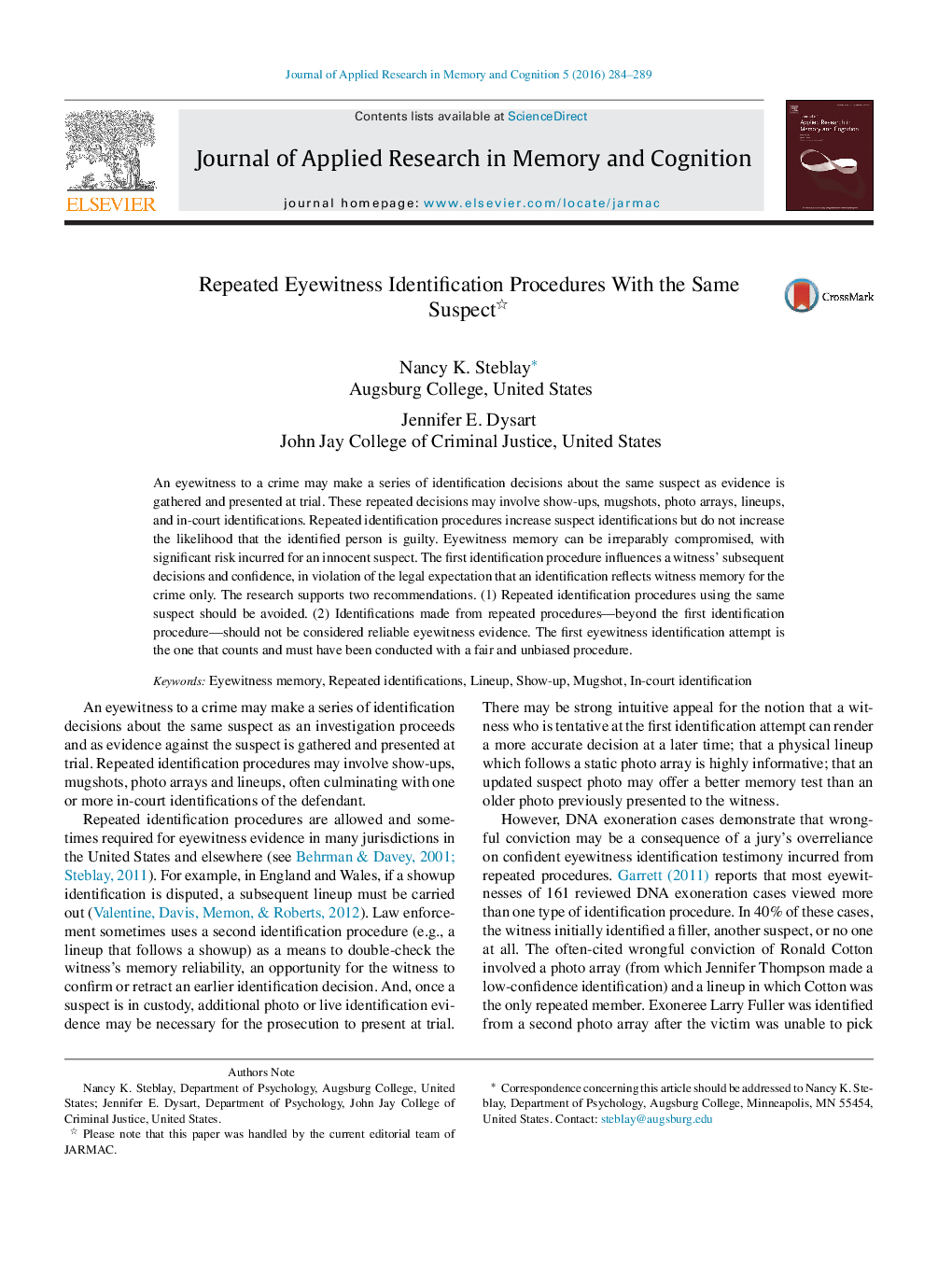| کد مقاله | کد نشریه | سال انتشار | مقاله انگلیسی | نسخه تمام متن |
|---|---|---|---|---|
| 5034044 | 1370051 | 2016 | 6 صفحه PDF | دانلود رایگان |
عنوان انگلیسی مقاله ISI
Repeated Eyewitness Identification Procedures With the Same Suspect
ترجمه فارسی عنوان
روشهای شناسایی شاهد عینی با همان مظنون
دانلود مقاله + سفارش ترجمه
دانلود مقاله ISI انگلیسی
رایگان برای ایرانیان
کلمات کلیدی
ترجمه چکیده
یک شاهد عینی برای یک جرم ممکن است مجموعه ای از تصمیمات شناسایی در مورد یک مظنون را به عنوان شواهد جمع آوری و ارائه در دادگاه. این تصمیمات مکرر ممکن است شامل ظهور، حواس پرتی، آرایه های عکس، ترکیبات و شناسایی در دادگاه باشد. روش های شناسایی تکراری شناسایی های مظنون را افزایش می دهند، اما احتمال این که فرد شناسایی شده مجرم باشد، افزایش نمی یابد. حافظه شاهدان میتواند به طور قابل ملاحظه ای در معرض خطر قرار گیرد و خطرناک است برای یک مظنون بیگناه. اولین روش شناسایی بر تصمیمات و اعتماد متقابل شاهد، با تخلف از انتظارات قانونی است که شناسایی نشان دهنده شاهد حافظه فقط برای جرم است. تحقیق دو توصیه را پشتیبانی می کند. (1) روشهای شناسایی تکراری با استفاده از یک مظنون مشابه باید اجتناب شود. (2) شناسایی های انجام شده از فرآیندهای مکرر - فراتر از روش شناسایی اولیه - نباید مدرکی قابل قبول شاهد عینی باشد. نخستین تلاش شناسایی شاهد عینی این است که شمارش می شود و باید با روش منصفانه و بی طرفانه انجام شود.
موضوعات مرتبط
علوم انسانی و اجتماعی
روانشناسی
روان شناسی کاربردی
چکیده انگلیسی
An eyewitness to a crime may make a series of identification decisions about the same suspect as evidence is gathered and presented at trial. These repeated decisions may involve show-ups, mugshots, photo arrays, lineups, and in-court identifications. Repeated identification procedures increase suspect identifications but do not increase the likelihood that the identified person is guilty. Eyewitness memory can be irreparably compromised, with significant risk incurred for an innocent suspect. The first identification procedure influences a witness' subsequent decisions and confidence, in violation of the legal expectation that an identification reflects witness memory for the crime only. The research supports two recommendations. (1) Repeated identification procedures using the same suspect should be avoided. (2) Identifications made from repeated procedures-beyond the first identification procedure-should not be considered reliable eyewitness evidence. The first eyewitness identification attempt is the one that counts and must have been conducted with a fair and unbiased procedure.
ناشر
Database: Elsevier - ScienceDirect (ساینس دایرکت)
Journal: Journal of Applied Research in Memory and Cognition - Volume 5, Issue 3, September 2016, Pages 284-289
Journal: Journal of Applied Research in Memory and Cognition - Volume 5, Issue 3, September 2016, Pages 284-289
نویسندگان
Nancy K. Steblay, Jennifer E. Dysart,
